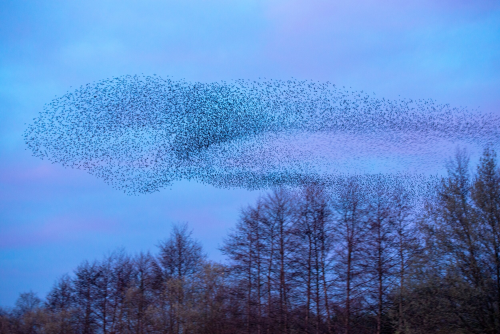
Complex systems made up of similar elements can exhibit emergent behavior. New, surprising properties may become manifest that cann’t be explained by examining basic elements alone. Well-known examples are the flight of a flock of starlings or the reflection color of a surface. What is shown is a manifestation of the total system. In general, chemical compounds exhibit properties that are very difficult to explain from the constituent elements. For example, the wonderful properties of water, such as the larger density of the liquid than of ice, are very difficult to predict from the properties of hydrogen and oxygen separately.
Researchers have two opposing views on this phenomenon. It can be an encouragement to carefully study the properties of the individual elements in relation to the way they interact. This is a bottom-up approach based on a physicalistic philosophy that assumes that everything can be explained from the basic laws of nature and the properties of the most fundamental particles. Researchers in this direction can get stuck for a long time because more complex systems are very difficult to analyze. Sometimes it appears almost impossible to find a convincing explanation. In the end, only a computer simulation might demonstrate that the studied phenomenon really follows from the basic assumptions. For some observers such a study may not be convincing, because now the simulation program must be examined carefully to avoid that extra, hidden properties have crept in.
Instead, the emerging properties can be accepted as new phenomena. This expands the basic assumptions needed to explain nature. They may at some point be combined with emergent properties of other systems. In this case, they are considered a manifestation of a higher level organization or organism. The flight of a flock of starlings is thus studied as a trait of the species and may be related to other traits or habits of the whole species. This could be followed by further upward studies focusing on the full habitat of a diversity of animal species. It may be necessary to relax the strict separation between cause and effect for such an approach to be fruitful.
The study of physical properties in general and of emergent properties in particular is complicated by the fact that these always depend on the context. For any physical experiment, the outcomes depend on the circumstances, in particular on the experimental set-up. The determination of a property is also based in one way or another on an experiment. Even in open nature, the observer influences the studied object. More complex systems are generally more sensitive to environmental influences. The flight variability of the flock of starlings is much greater than that of an individual starling. As a result, the definition of the measurement of emergent properties is a specific issue that needs careful analysis.
